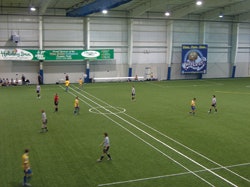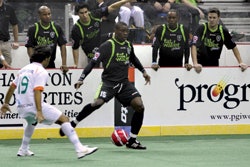Interest in boardless indoor soccer is rising, but for many facility owners, the numbers don't add up.
 WIDE OPEN An advantage of boardless soccer is that players can practice their throw-ins and touch-line ball handling just as they would on an outdoor field.
WIDE OPEN An advantage of boardless soccer is that players can practice their throw-ins and touch-line ball handling just as they would on an outdoor field.World Cup fever, which this summer was at a pitch not heard in the United States since the U.S. hosted the Cup in 1994, could mean a big jump in the number of adult players and even in the already huge number of youth players. But what will happen to all those newly minted footballers when their first kick-around is interrupted by inclement weather? Or, worse, winter?
In the large majority of communities, they'll get a shock the first time they step on an indoor soccer field. Despite using the same basic equipment and sharing the same objective of putting the ball in the back of the net, the games are fundamentally different because of the smaller field and the presence of dasher boards. The indoor game is faster-paced, with few of the out-of-bounds moments that allow outdoor players to catch their breath, and one-twos off the boards and rebounds from near-goals are among the unique skills needed to play the game well.
It's for this reason that the 2010 World Cup could spur continued development of the boardless variety of indoor soccer, which is in ascendance in certain communities and regions, or even alter the basic layout of existing boarded indoor soccer facilities to accommodate both styles of play.
Indoor soccer began with an 1885 match at Newark (Ont.) Roller Skating Rink and saw early development on 200-by-85-foot rinks intended for hockey, and indoor pitches have also been constructed inside converted tennis clubs, abandoned big-box stores and a variety of other pre-engineered, warehouse-style buildings. Indoor soccer has its own trade association, but in a possible indication of the sport's future, it's in the process of morphing from the United States Indoor Soccer Association to the United States Indoor Sports Association.
"We sort of, not really, changed our name," avers Don Shapero, the USISA's founder and president. "We have changed our branding such that the trade aspect of our organization is going by 'Sports,' and the sports side, for fans and coaches, is going by 'Soccer.' " Beyond such parsing, it is a step that suggests a shifting landscape. "The reason is to reflect the identity of our members as they've changed from soccer-only facilities," Shapero says.
The alterations have tended toward the programmatic rather than the physical, however. In most existing facilities, Ultimate Frisbee, flag football and lacrosse teams simply take to the fields, with the boards irrelevant to play. Facility owners who take this route do (or should) have one area of concern - nets strung in order to loosely corral soccer balls will pose a danger to spectators if counted on to stop stray lacrosse balls.
Accommodating other sports safely will also typically mean marking off fields of play inside the dashers, leaving an out-of-bounds area beyond touch lines and end lines. An often-cited advantage resulting from such a move is that players can practice their throw-ins and touch-line ball handling just as they would on an outdoor field. Shapero, however, downplays such a training benefit.
"Touches on the ball are a lot more important than whether there's a board or not, and the indoor style, with boards, vastly increases the number of touches," he says. "There are also certain drills you can run off the boards. I think it can be argued both ways, but I think it's ridiculous to think boardless play is superior in terms of player development."
 THE WALL One-twos off the boards and rebounds from near-goals are among the unique skills needed to play boarded indoor soccer well.
THE WALL One-twos off the boards and rebounds from near-goals are among the unique skills needed to play boarded indoor soccer well.The question is, player development for which sport? The fact is that for all the players who will come to The Beautiful Game from their World Cup-fueled awareness, there are an equal number who view indoor soccer as the better game. "There's a bit of a purist element coming into the indoor game," Shapero says. "The indoor game is characterized by fun and recreation, and those who play with boards tend to feel very strongly about that."
Facility owners feel most strongly about turning a profit, and Chris Guertin, founder of rink and indoor soccer supplier Sport Resource Group, believes that boarded fields offer the best opportunity to maximize revenue. "To me, it's a space issue - you can get more boarded fields into an area," Guertin says. "Trying to replicate the outdoor game indoors just takes up too much space."
As with repurposed tennis clubs, many of which were built with eight courts set astride a central corridor, big-box stores or supermarkets used for indoor soccer will often feature rows of supporting columns, making replicating the outdoor game impossible. The owner or builder of a long-span field house may not be able to resist the lure of an outdoor-style soccer pitch, but the building shell or operational budget might conspire against those plans (the minimum European dimension is 100 yards long by 50 wide; the maximum 130 by 100 yards). Shapero says that facility owners who try to fudge things - by creating an outdoor-style field that isn't of outdoor dimensions - might just be frustrating their most ardent user group. Owners do have the option (and most take it) of employing movable or retractable divider curtains to accommodate, when desired, a large number of small fields - but that won't satisfy fans of the boarded indoor game.
The Calgary Minor Soccer Association is one group that has experimented with both styles of play. A one-year trial in 2006-07 that saw U14 and U16 Tier I and II teams play with touch lines and end lines set within boarded fields was followed by an analysis of play - injury levels stayed the same, fitness levels of players dropped and games slowed significantly as many players had trouble controlling the ball around touch lines. Afterward, a survey of all facility users showed that 75 percent wanted to retain the boards, especially over-45 teams and Calgary's fastest-growing soccer demographic, coed teams. Boardless soccer's most enthusiastic players were U18 and U16 boys. "We thought we had a win-win, but we had a very divided group," says Daryl Leinweber, CMSA's executive director.
Yet, three years after tallying the questionnaires, CMSA is now considering doing away with boards entirely, just as soccer associations in Saskatchewan have done. "Even playing on boarded fields, kids essentially play boardless; it isn't until they're 10 that the boards start to become part of their game," Leinweber says. "We have to identify our objective - if it's to get kids active, we should leave the boards in, and if it's to improve the technical component of the sport, we should take the boards out."
"The overriding element in the decision about boards is, who's going to play there?" says Norm Gill, founder of indoor sports facility consultant Pinnacle Indoor Sports. "Are they playing indoor for fun, or training for outdoor? From an owner's standpoint, you have one commodity: time. How do you fill the facility as close to 365 days as you can? You can put in a large turf field with touch lines and have soccer, lacrosse, flag football, Ultimate and whatever else you want to put out there. Or you can put in a lot of boarded fields and be the place for indoor soccer. You have to know your clientele."
There are areas - southern Ontario, suburban New Jersey, Minneapolis - where boarded indoor fields hardly exist. But, as noted, there's a reason boards are used in 60 percent (Shapero's estimate) to as many as 80 percent (Guertin's estimate) of the U.S. and Canada's 650 indoor soccer facilities: Money.
"I'm sure there are some successful outdoor-style indoor facilities," Shapero says, "but I would imagine it's a much more difficult business proposition. Because you have half as many teams playing and longer game times, there are fewer rental periods. To compensate for that, you would have to charge significantly more than what you would normally charge an indoor soccer team. And then, in season, you start having to compete with outdoor leagues. As you go further into this analysis, the market seems to get smaller and smaller."




































